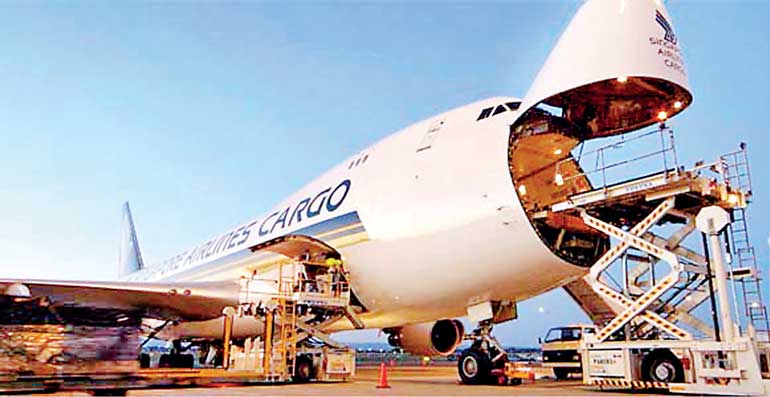Thursday Mar 13, 2025
Thursday Mar 13, 2025
Monday, 18 September 2017 10:21 - - {{hitsCtrl.values.hits}}
 The latest global air freight data from IATA shows that demand, measured in freight tonne kilometres (FTKs), increased by 11.4% in July 2017 compared to the same period a year ago.
The latest global air freight data from IATA shows that demand, measured in freight tonne kilometres (FTKs), increased by 11.4% in July 2017 compared to the same period a year ago.
This is the fourth time in five months that double-digit annual growth has been recorded. July’s year-on-year increase in demand was nearly four times higher than the ten-year average growth rate of 3.1%.
Freight capacity, measured in available freight tonne kilometres (AFTKs), grew by 3.7% year-on-year in July 2017.
The robust growth in air cargo demand was consistent with an uptick in global trade, rising export orders and upbeat business confidence indicators. There are, however, signs that demand growth for air freight may be nearing a peak. Seasonally-adjusted air freight volumes were flat in June and fell in July; and the global inventory-to-sales ratio has stabilised. Air cargo often sees a boost in demand at the beginning of an economic upturn as companies look to restock inventories quickly. This tapers as inventories are adjusted to new demand levels.
“July was a strong month for air cargo with double-digit growth. And for the third consecutive month demand for air freight grew at a faster pace than demand for air travel. While the outlook for the rest of the year remains positive, there are signs that the cyclical growth period may be nearing a peak,” said IATA’s Director General and CEO Alexandre de Juniac.
All regions posted robust freight growth in July 2017.
Asia Pacific airlines’ freight volumes grew 11% in July 2017 compared to the same period a year earlier and capacity increased by 6.3%. Demand growth was robust on all the major routes to, from and within the region. Seasonally-adjusted international freight volumes fell slightly in July but remain more than 3% above the volumes reached following the 2010 post-global financial crisis bounce-back.
North American carriers posted an increase in freight volumes of 11.9% in July 2017, and a capacity increase of 1.1%. Seasonally-adjusted international freight volumes continued their strong upward trend. The strength of the US dollar has boosted the inbound freight market over the past few years. Data from the US Census Bureau showed a 12.5% increase in air imports to the US in the first half of 2017. However, the decline in the US dollar since the start of the year is likely to help rebalance trade flows.
European airlines posted a 12.1% increase in freight demand in July 2017 and a capacity increase of 5.5%. Double-digit growth in international demand has now been recorded in nine out of the past 11 months, bolstered by strong demand in the Europe-Asia market. While export orders remain strong, the recent strengthening of the Euro may begin to weigh upon the region’s exporters.
Middle Eastern carriers’ year-on-year freight volumes increased 9.3% in July 2017 and capacity decreased 0.4%. Seasonally-adjusted international freight volumes have maintained their solid upward trend. However, amid strong competition from other regions’ carriers, particularly on the Asia-Europe route, Middle East carriers are not seeing as strong a pickup in the seasonally adjusted traffic trend as other regions’ carriers.
Latin American airlines experienced a growth in demand of 5.8% in July 2017 compared to the same period in 2016. Capacity increased by 4.7% over the same period. Seasonally-adjusted international freight volumes grew strongly in July 2017. However, they remained 9% lower than at the peak in 2014. The region continues to be impacted by challenging economic and political conditions, particularly in the largest economy Brazil.
African carriers posted the largest year-on-year increase in demand of all regions in July 2017 with freight volumes growing 33.7% - the second fastest monthly rise in seven years. Capacity increased by 4.5% over the same time period. Demand has been boosted by very strong growth on the trade lanes to and from Asia which increased 80% year-on-year in June (latest available data) and by 65% in the first half of the year.
Discover Kapruka, the leading online shopping platform in Sri Lanka, where you can conveniently send Gifts and Flowers to your loved ones for any event including Valentine ’s Day. Explore a wide range of popular Shopping Categories on Kapruka, including Toys, Groceries, Electronics, Birthday Cakes, Fruits, Chocolates, Flower Bouquets, Clothing, Watches, Lingerie, Gift Sets and Jewellery. Also if you’re interested in selling with Kapruka, Partner Central by Kapruka is the best solution to start with. Moreover, through Kapruka Global Shop, you can also enjoy the convenience of purchasing products from renowned platforms like Amazon and eBay and have them delivered to Sri Lanka.
Discover Kapruka, the leading online shopping platform in Sri Lanka, where you can conveniently send Gifts and Flowers to your loved ones for any event including Valentine ’s Day. Explore a wide range of popular Shopping Categories on Kapruka, including Toys, Groceries, Electronics, Birthday Cakes, Fruits, Chocolates, Flower Bouquets, Clothing, Watches, Lingerie, Gift Sets and Jewellery. Also if you’re interested in selling with Kapruka, Partner Central by Kapruka is the best solution to start with. Moreover, through Kapruka Global Shop, you can also enjoy the convenience of purchasing products from renowned platforms like Amazon and eBay and have them delivered to Sri Lanka.